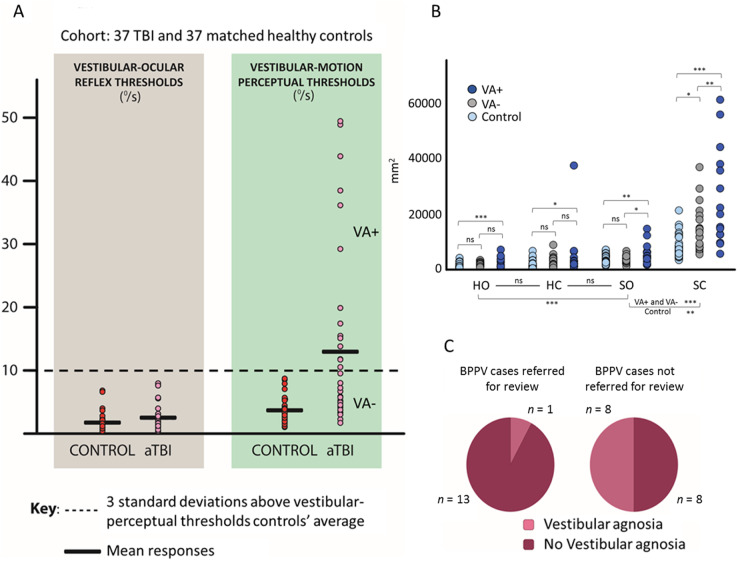Figure 2.
Vestibular threshold testing. (A) Vestibular agnosia in acute TBI. Vestibular-ocular (left) and vestibular-perceptual (right) thresholds to angular acceleration, in healthy controls (dark red) and acute TBI patients (light pink): the acceleration thresholds are displayed in terms of the equivalent instantaneous angular velocity at the time of the threshold detection. Vestibular-ocular thresholds (expressed in degrees per second), correspond to the minimum angular velocity needed to elicit a vestibular-ocular response (first slow-phase of a nystagmus with minimum of two slow and fast phase components). Perceptual thresholds (expressed in degrees per second), correspond to the minimum angular velocity needed to induce the perception of self-motion in the correct direction as assessed by the MOBS procedure. (B) Imbalance in acute TBI assessed via posturography. Sway expressed in square millimetres as the area of the 95% bivariate confidence ellipse of the total displacement of the centre of pressure, in the four posturography conditions (HO = hard surface with eyes open; HC = hard surface with eyes closed; SO = soft surface with eyes open; SC = soft surface with eyes closed), in controls (light blue), acute TBI patients without vestibular agnosia (VA-, grey), and acute TBI patients with vestibular agnosia (VA+, blue). ns = not significant. *P < 0.05; **P < 0.01; ***P < 0.001. (C) Clinically apparent vestibular agnosia masks the presence of BPPV in acute TBI. Left: Patients with BPPV, diagnosed after being referred by the ward clinical staff (n = 14). Right: Patients with BPPV, who were not referred by the ward clinical staff, but diagnosed by our systematic screening on the trauma ward (n = 16). The dark red sectors represent the proportions of patients who reported dizziness during manoeuvres, i.e. they did not have vestibular agnosia. The light pink sectors represent the patients with vestibular agnosia, i.e. they denied dizziness on direct questioning, during manoeuvres that triggered a vestibular nystagmus indicative of BPPV.

